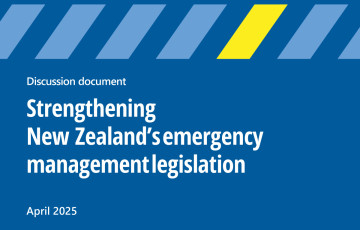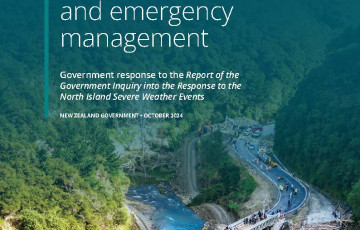Weekly Update from the Cyclone Recovery Unit – 22 May 2023
Update from the Cyclone Recovery Unit
The Cyclone Recovery Unit is working alongside the Cyclone Recovery Taskforce and other Government agencies to support the worst affected regions to recover from the impacts of the North Island floods and Cyclone Gabrielle.
This week we have one-page updates from the Ministry for Primary Industries, MBIE and Waka Kotahi. You’ll find them attached below.
New National Resilience Plan
In Budget 2023 a National Resilience Plan was announced, setting aside $6 billion for strategic investments as part of a National Resilience Plan.
This investment will initially focus on building back better from the recent weather events. It will also include future proofing road, rail, and local infrastructure wiped out by the extreme weather, as well as telecommunications and electricity transmission infrastructure.
Read more HERE
Flood and Cyclone recovery package to rebuild and prepare
The Government has announced a billion-dollar flood and cyclone recovery package as part of Budget 2023 that covers the basics of rebuilding roads, rail and schools while preparing for future events with a big investment in flood protection measures.
The Package includes funding to:
- Rebuild and repair roads, rail and repair and rebuild all weather-hit schools
- $100 million in flood protection to prevent future flooding; read more HERE
- Child mental health support to be provided to all primary and intermediate schools in Hawkes Bay and Tairāwhiti via Mana Ake. Read more HERE
- Investment in job training and employment
Treasury has estimated the damage from Cyclone Gabrielle and the Auckland Floods could range from $9 billion to $14.5 billion, second behind only the Canterbury earthquakes in terms of damage from natural disasters New Zealand has faced. Of this, $5 to $7.5 billion of damage is expected to relate to infrastructure owned by central and local government.
Read more HERE
The Future of Severely Affected Locations
Hawke’s Bay, Tamaki Makaurau Auckland, and Te Tairāwhiti were three regions hit hardest by Cyclone Gabrielle and severe weather events this year.
The Cyclone Recovery Taskforce has been working with councils and insurance companies to assess the risk status of locations within the regions. This is directly feeding into being able to categorise locations according to risk. This then will lead to discussions with affected communities about the categorisation and risk as well as the options that are likely to be available. These discussions will help to ensure that all the issues people in these locations are facing are known and factored in as risk assessments and options are further refined.
Different councils are at different stages of this assessment, but regardless of this council staff, insurance companies, central government and the Taskforce all recognise the need to provide certainty as soon as possible – even if that certainty is clarity around what next steps look like.
Recovery will take time, but everyone is working fast to give people certainty about what next, to help them move on with their lives.
The journey ahead remains a team effort. Local and regional councils together with central government, will work closely with communities to ensure their needs and priorities are reflected in the region’s recovery planning.
As well as locally impacted communities in the Hawke’s Bay and Auckland, the Taskforce is engaging with the banking sector, insurance sector, and infrastructure in order to ensure local, iwi, and business voices have input into decision making, and to align the economic and infrastructure recovery efforts.
Next Steps
The Cyclone Recovery Unit is supporting regional recovery agencies and local councils to develop community discussions and engagement plans and will support the engagement itself as needed.
In Hawke’s Bay, all affected residents are expected to be advised that their home is either in category 1, or in categories 2 and 3 by 31 May, and community meetings with affected homeowners will begin in June.
Auckland and Te Tairāwhiti are in planning stages and engagement with affected communities will follow.
Big Check-in Webinar
On 4 May over 400 people joined ‘The Big Check-In’ online event, convened by the Primary Sector Wellbeing Reference Group for rural communities to connect following Cyclone Gabrielle. The webinar featured four expert panellists sharing experiences and practical advice for people affected. The webinar was recorded and is designed as a resource that can be used by individuals or watched and discussed at community events. Watch it HERE
Finding Support
Communities and People
Community groups and contracted social sector providers of food and other supports, including services for disabled people have mobilised quickly to support people, families and communities affected by the recent North Island floods and Cyclone Gabrielle. The increase in demand for this support is putting a strain on services and community-led initiatives. There is a Community Support Package aims to relieve some of this pressure so community groups and contracted providers can continue to deliver their response and recovery efforts for people, whānau and communities. See more here: Community Support Package for people impacted by North Island floods and Cyclone Gabrielle - Ministry of Social Development (msd.govt.nz)
Also, check out Te Whatu Ora’s resources here: https://www.tewhatuora.govt.nz/keeping-well/cyclone-support/
The Temporary Accommodation Service is supporting those who have been displaced. Find out more here: Temporary Accommodation Service » Temporary Accommodation (mbie.govt.nz)
The Ministry of Business, Innovation and Employment has launched the New Zealand Claims Resolution Service to advise and support homeowners to resolve residential insurance issues. This can include legal, engineering and wellbeing support. More details here: New Zealand Claims Resolution Service (nzcrs.govt.nz)
Business
More than 3500 small businesses have been approved for grants to support their recovery. Businesses can apply for a grant of up to $40,000 to help them keep operating, maintain cashflow and position them for a successful recovery. There is more detail on support available to businesses here: Cyclone and flood recovery for businesses — business.govt.nz and here: Employer support for Cyclone Gabrielle in Tairāwhiti and Hawke's Bay - Work and Income
Support for Māori
Te Puni Kōkiri is distributing $9m of the $15m allocated to support Māori recover from Cyclone Gabrielle through the Cyclone Gabrielle Māori Communities Response Fund providing:
- Capacity support such as relief staffing, clean-up expenses, generators and communication equipment
- Recovery planning and co-ordination funds
- Marae infrastructure and support funds such as securing temporary storage for taonga and food.
At the end of April 2023, $7.84m has been committed, is being processed or is under discussion across affected regions of Ikaroā-Rāwhiti – Takitimu, Ikaroā-Rāwhiti – Tairāwhiti, Te Tai Tokerau, Tāmaki-Makarau and Waikato-Waiariki.
Te Puni Kōkiri kaimahi are also helping whānau identify and connect into other recovery focused government funds. The Ministry has an important role in times like these, to support other agencies to understand and reflect the needs of whānau Māori in their recovery approaches.
For enquiries about Te Puni Kōkiri funding in cyclone affected regions contact a Te Puni Kōkiri regional office.
Government support to date
- An initial $250 million for Waka Kotahi and local councils to assess and fix roads
- $74 million for affected farmers and growers to clean up and re-establish their businesses
- $75 million for businesses with immediate costs and clean-up – to be distributed by local delivery partners in the affected regions
- $5 million to Mayoral Relief Funds
- More than $65.8 million in Civil Defence Payments
- Inquiry announced into forestry slash and land use after Cyclone Gabrielle
- A new Recovery Visa created to help bring in additional specialist workers
- Temporary Accommodation Service activated in affected regions
- Cyclone Gabrielle Appeal Fund Launched along with a special Lotto Draw on Saturday 18 March
- $15 million short-term relief package to support Māori communities
- A further $17.5 million to support communities and community providers
- $3.25 million to support the immediate mental wellbeing needs of people impacted by Cyclone Gabrielle
- $15 million for councils to remove rubbish
- $133.2 million for Hawke’s Bay and $38.8 million for Tairāwhiti to remove silt from residential, commercial properties and whenua Māori.
- $275 million for Waka Kotahi and local councils to repair affected roads
- $200m to repair railways
- $117 million to repair, re-develop or relocate schools affected by the severe weather
- $100 million in flood protection to prevent future flooding
- $35 million for mental health initiatives
- $10.5 million to remove slash and debris in Hawke’s Bay and Tairāwhiti
One-page summaries
- Ministry for Primary Industries Cyclone Gabrielle Recovery Report 15 May 2023 (.pdf 411kb)
- Ministry of Business, Innovation and Employment recovery at a glance 15 May 2023 (.pdf 115kb)
- Waka Kotahi Cyclone Gabrielle Recovery Activity Weekly Update 18 May 2023 (.pdf 244kb)
Published: May 22, 2023, 3:42 PM



